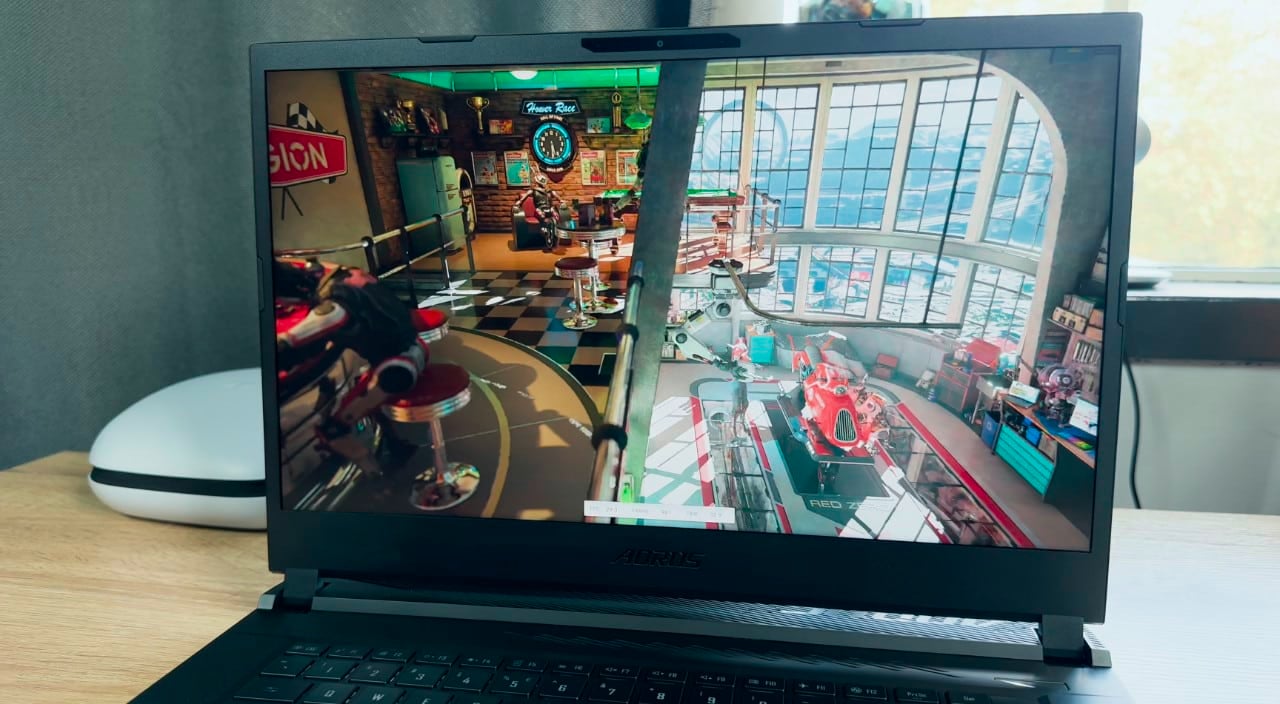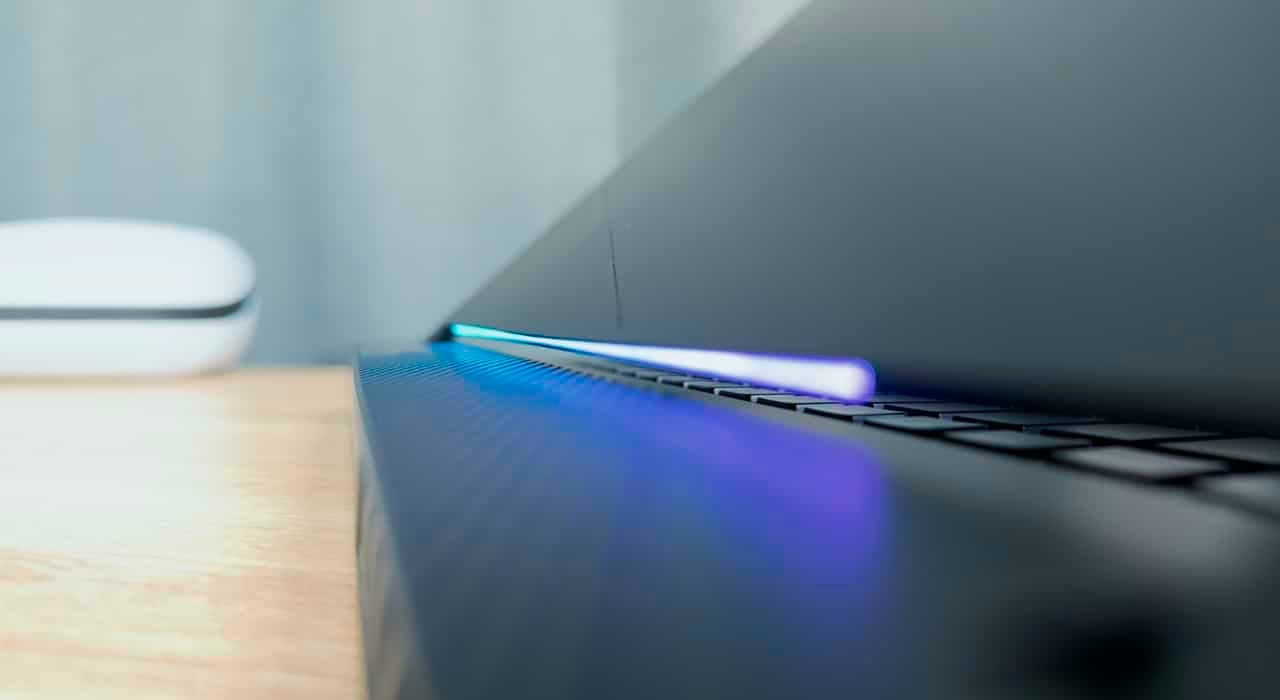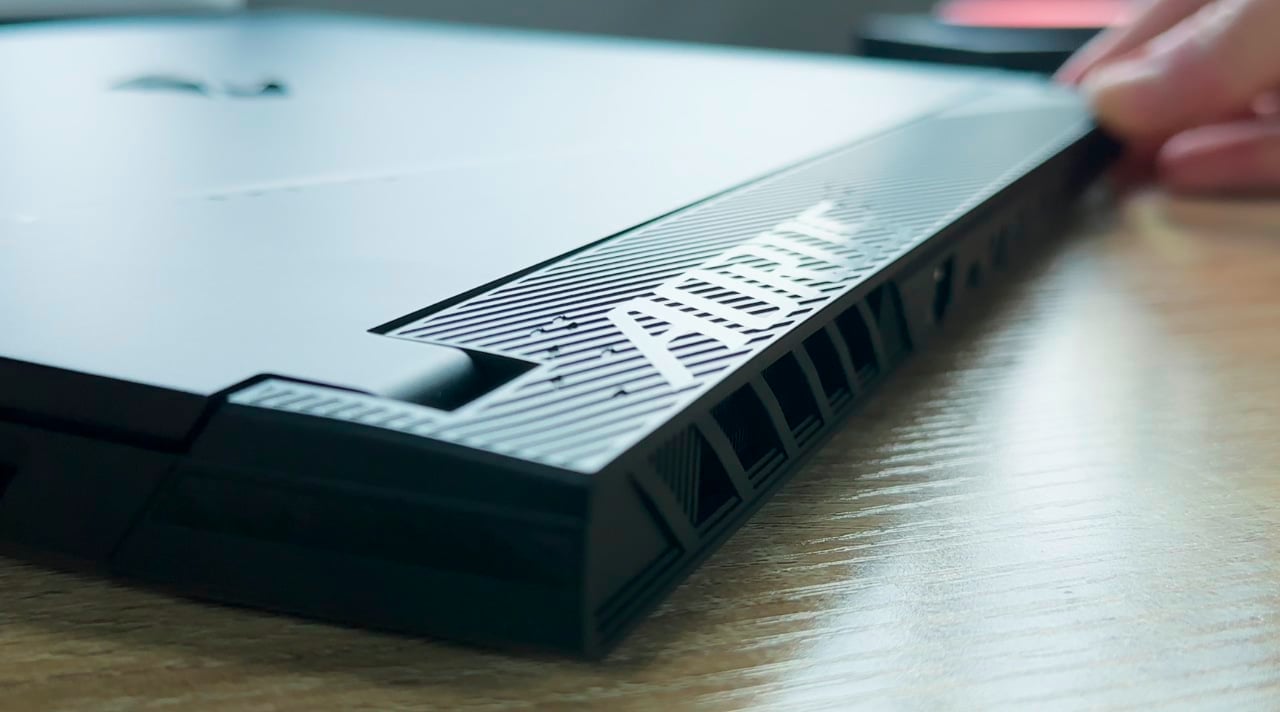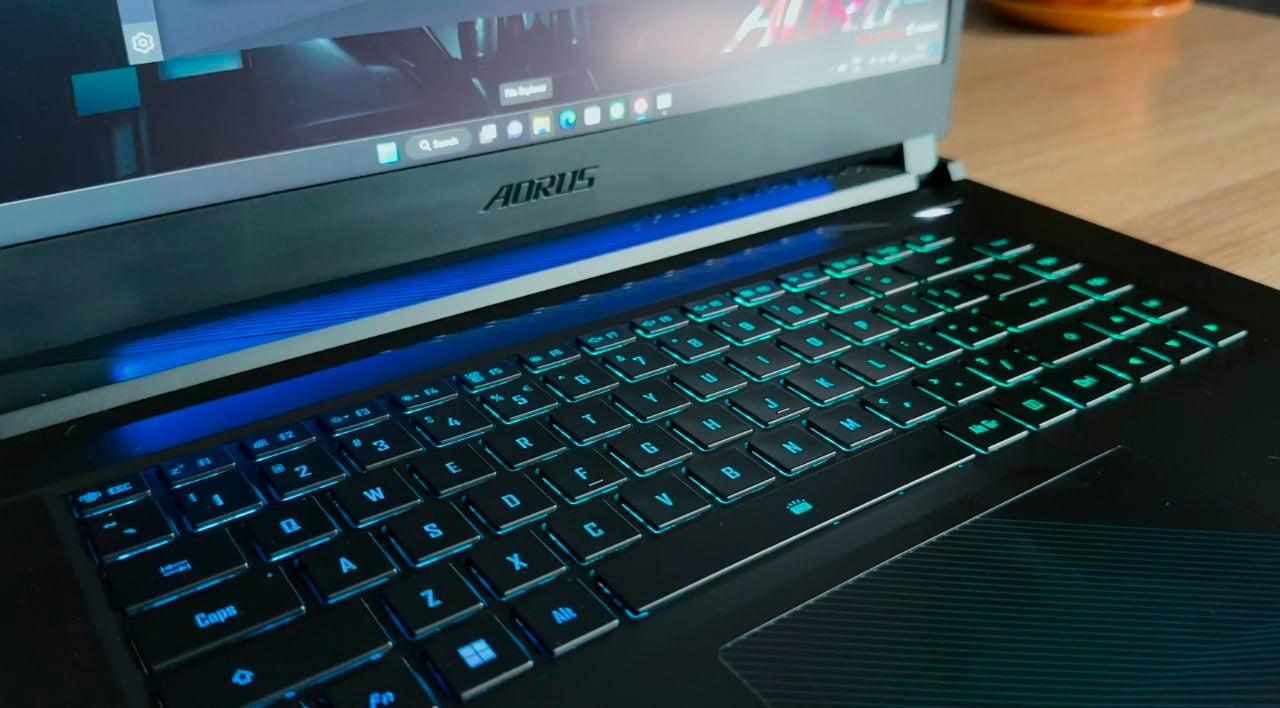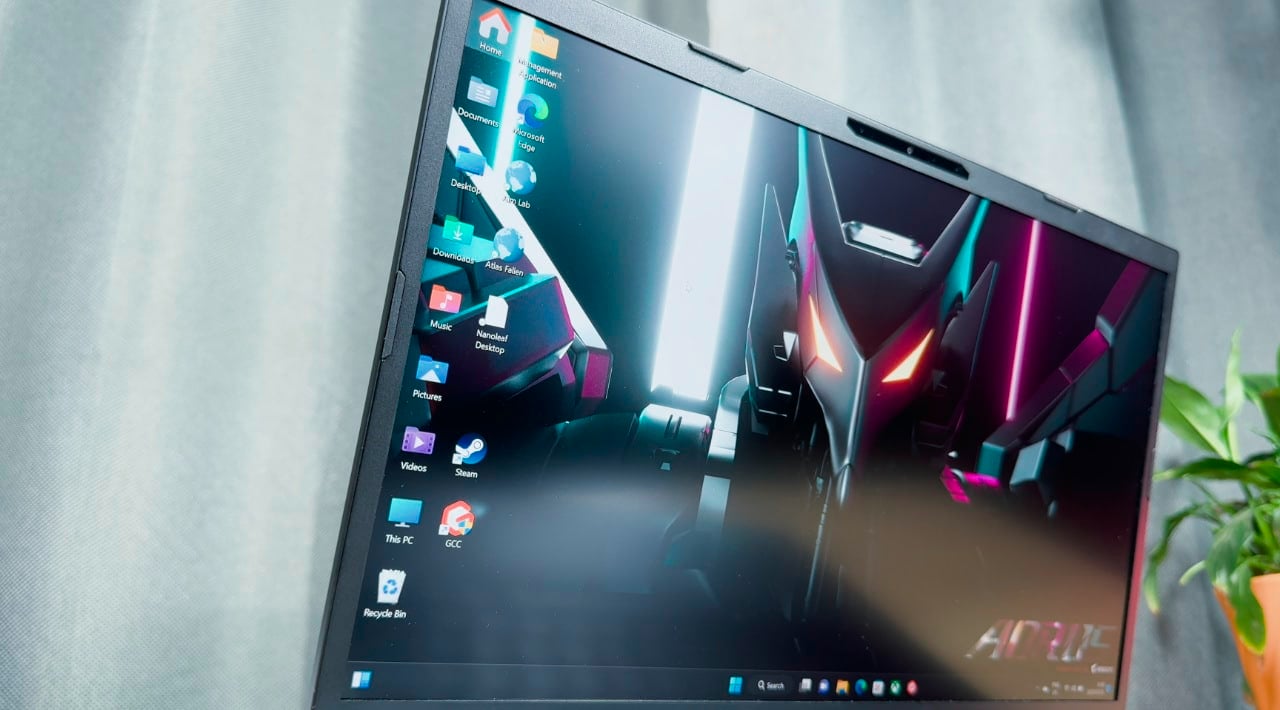I feel like it has been ages since I got my hands on a Gigabyte notebook. In fact, the last one I reviewed was the Aero 16 way back in February last year so when the company told me I was getting a new 40-series Aorus model, I was actually quite excited to see what Gigabyte has been up to on its gaming range. This new Gigabyte Aorus 15 is one of the latest notebooks to pack a 13th Gen CPU in it alongside a 40-series NVIDIA RTX GPU.
Watch the Gigabyte Aorus 15 BSF review below
If you want the technical tag for this exact notebook, it is the Gigabyte Aorus 15 BSF model. This is the top-of-the-range unit. Gigabyte also makes a BFK model which comes with an RTX 4060 instead of an RTX 4070. Both the BSF and BFK models include either a 13th gen Core-i7 13700H CPU or a 13th gen Core-i5 13500H CPU. You can also pick both notebook variants up in a range of different displays.
They are all 15.6 inches but come in a 1080p 144Hz panel, 1080p 240Hz panel, a 1080p 360hz panel and a QHD 2560×1440 165Hz panel. The model in this review packs a QHD panel. I will leave links down below where you can see the breakdown of all the models on offer by Gigabyte.
If anything, this Gigabyte AORUS 15 BSF notebook is the brand’s entry-level option for dedicated RTX 40-series devices. You can also look at getting an Aorus 17 which packs a range of 40-series GPUs but if you’re looking for a more compact option, this is definitely it. The full specs for this device include the following:
Gigabyte AORUS 15 BSF Tech Specs
- OS: Windows 11 Pro
- CPU: Intel 13th Gen Core-i7 13700H 5.0GHz
- GPU: NVIDIA RTX 4070 8GB DDR6 GPU + Intel Iris Xe Graphics
- Display: 15.6 16:9 Thin Bezel QHD 2560 x 1440 165Hz
- RAM: 2 x DDR5 16GB 4800MHz RAM (max 64GB upgradable)
- Storage: 2 x M.2 SSD slots (PCIe Gen 4.0×4) – 1TB in this model
- Keyboard: Three-Zone RGB keyboard with Per-Key Macro
- Ports
- Left Side:
- 1 x USB 3.2 Gen1 (Type-A)
- 1 x Audio combo Jack
- Right Side
- 2 x USB 3.2 Gen2 (Type-A)
- 1 x USB 3.2 Gen2 (Type-C)
- Rear Side
- 1 x Thunderbolt™ 4 (Type-C, support Power delivery)
- 1 x HDMI 2.1
- 1 x Mini DP 1.4
- 1 x RJ45
- 1 x DC-in
- Audio: 2 x 2W speaker / Microphone / DTS:X Support
- Communications: Wi-Fi 6E (802.11ax) (Triple band) 2×2 Bluetooth: Bluetooth V5.2
- Webcam: Yes (FHD 1080p) with Windows Hello Face Authentication
- Battery: 99Wh
- Power Adapter: 240W
- Dimensions: 36.0(W) x 27.2(D) x 2.09(H) cm / 2.25Kg
Gigabyte AORUS 15 BSF Design
Gigabyte has done a lot with this AORUS 15 to make it look and feel like an actual generational step forward. While the notebook still boasts its typical black frame design which hasn’t changed in a few years now, the minor tweaks to the shell finally make this notebook stand out from its Aero range. I have taken issue in the past with the Aorus lineup basically copying the exact same chassis as the Aero and simply slapping an Aorus logo on the lid. That isn’t the case this time around.
I am not saying that the changes are drastic but a few decals here and there and an entirely new port placement are definitely a welcome change in the range. The AORUS 15 BSF is a hefty chunk of metal and plastic. The top of the notebook boasts a mirror finish Aorus logo on it and a metal shell material. The rest of the device is plastic. This includes the inner keyboard section and underneath the notebook too.
The port placement is the first big change I spotted on the AORUS 15. Instead of cramming all the ports to the left and right-hand side, Gigabyte has placed the majority of them at the back and it is definitely a welcome addition. This means that you’ll no longer need to fight between cables while gaming when it comes to charging. The back is packed full of some pretty impressive IO including an HDMI 2.1 port, Mini DisplayPort 1.4, the DC power port and a Thunderbolt 4 port with power delivery support. There’s also an RJ45 port.
On the right-hand side is where you’ll find two USB 3.2 Gen 1 Type-A ports and one USB 3.2 Gen2 Type-A port. On the left, there’s one USB 3.2 Gen 1 Type-A port and an audio jack combo. All the USB ports also have black plastic internal sockets on them which I thought was pretty cool. You’ll have to remember which ones are Gen 1 and Gen 2 but the black slots look super sleek on the black shell of the notebook.
Given that the ports are now on the back, Gigabyte has had to increase the space a bit at the back of the notebook too. You’ll definitely notice a chunkier back end of this AORUS 15 BSF but it looks cool with the AORUS logo embossed into the ribbed plastic. Gigabyte has taken it a step further and added some RGB lighting to the bottom of the display lid to take advantage of this extra empty space. It now lights up thanks to this small strip of RGB.
Speaking of the display lid, I have to say I wasn’t very impressed with how thin these so-called “Thin Bezels” were on the display. Gigabyte markets its displays as “Thin Bezel” but the space between the display and the end of the lid leaves a lot to be desired. In 2023, there are much thinner bezels out there. Even the bottom of the display packs quite a thick plastic frame around it.
If anything, it looks a bit dated in comparison to what PC makers are now doing with 16-inch displays. I kinda feel like this notebook had more than enough space around the display to not only shrink down the bezels but also turn the display into a 16:10 panel. The webcam does take up a lot of space due to the IR blaster for Windows Hello support but the bottom kinda feels empty.
Apart from that, I did find things to love about this AORUS 15 BSF. The touchpad is fairly large and boasts a cool 3D vector design on it. The power button isn’t in the middle of the display as it has been for the longest time. I also thought the extra rubber pads on the left and right-hand side of the display were nice to have for some extra padding and protection.
I also liked the vents at the back. The flat design looks so clean and even the vent fins were flush with the back. I don’t know why but somehow it spoke to that minimalist inside me. There are also a few nice finishes around the Aorus logo and some metallic writing on the back fins too. I have no clue what it says but it was nice to look at. I also like how the display’s RGB can be seen with the lid closed and lit up when I plugged the notebook in to charge. However, it triggered me when the light didn’t stretch from one end to the other but instead was only in the middle of the display.
The one issue I did have was with the keyboard. It isn’t great. Typing on the keys, the keyboard felt a bit wobbly as if there was a hollow portion underneath a section of the keyboard which was being pressed down on. Only the right-hand side of the keyboard had this issue and you can see all the keys around the JKL keys moving about when pressed down. Doing the same thing on the left-hand side near the ASD keys, it was stable in comparison to the other half.
Gigabyte AORUS 15 BSF Performance
The AORUS 15 packs an RTX 4070 Max-Q GPU which means there’s the latest chip inside this notebook which should be able to max out the notebook’s QHD display. The GPU has a max power of 140W and a boost clock of 2175MHz. With that in mind, I ran some benchmarks and tested out the notebook under a range of settings. Of course, you can enable the MUX switch on this device too and crank its performance to the max using the Gigabyte Control Centre.
I made sure to run not only some DLSS3-supported games but also benchmarks on titles with DLSS3 disabled. All tests were also run at the max resolution on the display which is 2560 x 1440.
3DMark DLSS Test (Performance)
- DLSS On: 62.14fps
- DLSS Off: 14.65fps
3DMark Speed Way
- Overall: 2887
3DMark Time Spy Extreme
- Overall: 12251
- Graphics: 11972
Returnal
- Epic (Raytracing Off / DLSS Off)
- Average: 90fps
- Epic (Raytracing On / DLSS Off
- Average: 76fps
Hogwarts Legacy
- Ultra (Raytracing Off)
- Average: 71fps
- Ultra (Raytracing On)
- Average: 45fps
The Witcher 3
- Ultra
- Average: 55fps
Marvel’s Spider-Man: Miles Morales
- Very High (Raytracing On)
- Average: 70fps
A Plague Tale: Requiem
- Ultra Settings
- Average: 39fps
Dying Light 2
- High Quality
- Average: 62fps
- High Quality Raytracing On
- Average: 42fps
Cyberpunk 2077
- Raytracing Ultra (DLSS On Auto)
- Average: 77fps
- Min: 31fps
- Max: 107fps
- Raytracing Ultra (DLSS Off)
- Average: 63fps
- Min: 47fps
- Max: 89fps
- Raytracing Ultra (DLSS Ultra Performance)
- Average: 109fps
- Min: 54fps
- Max: 165fps
Far Cry 6
- Ultra Quality Raytracing Off
- Average: 91fps
- Ultra Quality Raytracing On
- Average: 69fps
Watch Dogs Legion
- Ultra Preset Raytracing Off
- Average: 68fps
- Ultra Preset Raytracing On
- Average: 45fps
Shadow of the Tomb Raider
- Maxed Settings
- Average: 121fps
General use of the AORUS 15 was surprisingly quiet when it came to the fans running in eco mode. I have dealt with a lot of noisy notebooks in the past and this one wasn’t one of them. Just daily tasks like web browsing and video watching while using the Eco mode fan profile resulted in a somewhat peaceful session. This would be the mode you would want to use in meetings or if you just want a bit of silence Of course, when gaming and with the Turbo mode activated, the fans kick in and they were very loud. I measured 59dB at times during the most intense tests. It was quite difficult to ignore these fans.
In terms of the heat, the Gigabyte AORUS 15 BSF does a decent job of keeping things cool. Gaming does get hot but not any hotter than your typical 40-Series RTX notebook. I measured 79C on the GPU after a full hour of benchmarking and gaming. The body of the notebook hit 55C at its peak which was right in the middle of the device. However, idle temperatures stayed at a reasonable 30-35C.
Apart from that, the speakers on the notebook were also okay. I feel like Gigabyte hasn’t actually tweaked or improved its notebook speakers in about four or five years now. All the notebooks I review sound pretty much the same. As to say, they are just okay and you’ll likely want headphones for gaming. The webcam is also fairly decent. Not many notebooks come with a 1080p camera and this one handles its image decently. I did struggle a bit with the exposure levels and the camera doesn’t work well at all in any sort of low-light environment. You’ll need a bright room.
In the end, I was happy with the Gigabyte AORUS 15’s somewhat refreshing design. However, underneath the few decals here and there, this is pretty much as Gigabyte as any notebook you’ve had from the brand in the past. The internals make this a real step forward thanks to the 4070 Ti and the 13th-Gen i5. Combined, you can get away with basically all games running at 1440p 60fps and toss in some ray tracing settings too. I would say this is a great notebook that doesn’t try to be anything it is not.
Gigabyte Aorus 15 BSF Review
Summary
The Gigabyte Aorus 15 BSF is a powerful RTX 4070 gaming notebook that doesn’t break any barriers but offers some decent value for money and some great specs.
Overall
8.5/10Pros
RTX 4070
Nice small details on design
Crisp display
Cons
Large bezel display
Loud fans


